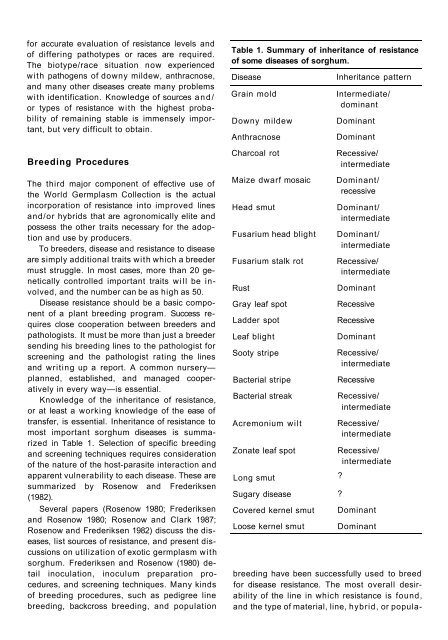Sorghum Diseases in India
Sorghum Diseases in India
Sorghum Diseases in India
Create successful ePaper yourself
Turn your PDF publications into a flip-book with our unique Google optimized e-Paper software.
for accurate evaluation of resistance levels and<br />
of differ<strong>in</strong>g pathotypes or races are required.<br />
The biotype/race situation now experienced<br />
with pathogens of downy mildew, anthracnose,<br />
and many other diseases create many problems<br />
with identification. Knowledge of sources and/<br />
or types of resistance with the highest probability<br />
of rema<strong>in</strong><strong>in</strong>g stable is immensely important,<br />
but very difficult to obta<strong>in</strong>.<br />
Breed<strong>in</strong>g Procedures<br />
The third major component of effective use of<br />
the World Germplasm Collection is the actual<br />
<strong>in</strong>corporation of resistance <strong>in</strong>to improved l<strong>in</strong>es<br />
and/or hybrids that are agronomically elite and<br />
possess the other traits necessary for the adoption<br />
and use by producers.<br />
To breeders, disease and resistance to disease<br />
are simply additional traits with which a breeder<br />
must struggle. In most cases, more than 20 genetically<br />
controlled important traits will be <strong>in</strong>volved,<br />
and the number can be as high as 50.<br />
Disease resistance should be a basic component<br />
of a plant breed<strong>in</strong>g program. Success requires<br />
close cooperation between breeders and<br />
pathologists. It must be more than just a breeder<br />
send<strong>in</strong>g his breed<strong>in</strong>g l<strong>in</strong>es to the pathologist for<br />
screen<strong>in</strong>g and the pathologist rat<strong>in</strong>g the l<strong>in</strong>es<br />
and writ<strong>in</strong>g up a report. A common nursery—<br />
planned, established, and managed cooperatively<br />
<strong>in</strong> every way—is essential.<br />
Knowledge of the <strong>in</strong>heritance of resistance,<br />
or at least a work<strong>in</strong>g knowledge of the ease of<br />
transfer, is essential. Inheritance of resistance to<br />
most important sorghum diseases is summarized<br />
<strong>in</strong> Table 1. Selection of specific breed<strong>in</strong>g<br />
and screen<strong>in</strong>g techniques requires consideration<br />
of the nature of the host-parasite <strong>in</strong>teraction and<br />
apparent vulnerability to each disease. These are<br />
summarized by Rosenow and Frederiksen<br />
(1982).<br />
Several papers (Rosenow 1980; Frederiksen<br />
and Rosenow 1980; Rosenow and Clark 1987;<br />
Rosenow and Frederiksen 1982) discuss the diseases,<br />
list sources of resistance, and present discussions<br />
on utilization of exotic germplasm with<br />
sorghum. Frederiksen and Rosenow (1980) detail<br />
<strong>in</strong>oculation, <strong>in</strong>oculum preparation procedures,<br />
and screen<strong>in</strong>g techniques. Many k<strong>in</strong>ds<br />
of breed<strong>in</strong>g procedures, such as pedigree l<strong>in</strong>e<br />
breed<strong>in</strong>g, backcross breed<strong>in</strong>g, and population<br />
Table 1. Summary of <strong>in</strong>heritance of resistance<br />
of some diseases of sorghum.<br />
Disease Inheritance pattern<br />
Gra<strong>in</strong> mold Intermediate/<br />
dom<strong>in</strong>ant<br />
Downy mildew Dom<strong>in</strong>ant<br />
Anthracnose Dom<strong>in</strong>ant<br />
Charcoal rot Recessive/<br />
<strong>in</strong>termediate<br />
Maize dwarf mosaic Dom<strong>in</strong>ant/<br />
recessive<br />
Head smut Dom<strong>in</strong>ant/<br />
<strong>in</strong>termediate<br />
Fusarium head blight Dom<strong>in</strong>ant/<br />
<strong>in</strong>termediate<br />
Fusarium stalk rot Recessive/<br />
<strong>in</strong>termediate<br />
Rust Dom<strong>in</strong>ant<br />
Gray leaf spot Recessive<br />
Ladder spot Recessive<br />
Leaf blight Dom<strong>in</strong>ant<br />
Sooty stripe Recessive/<br />
<strong>in</strong>termediate<br />
Bacterial stripe Recessive<br />
Bacterial streak Recessive/<br />
<strong>in</strong>termediate<br />
Acremonium wilt Recessive/<br />
<strong>in</strong>termediate<br />
Zonate leaf spot Recessive/<br />
<strong>in</strong>termediate<br />
Long smut<br />
Sugary disease ?<br />
Covered kernel smut Dom<strong>in</strong>ant<br />
Loose kernel smut Dom<strong>in</strong>ant<br />
breed<strong>in</strong>g have been successfully used to breed<br />
for disease resistance. The most overall desirability<br />
of the l<strong>in</strong>e <strong>in</strong> which resistance is found,<br />
and the type of material, l<strong>in</strong>e, hybrid, or popula-<br />
?








